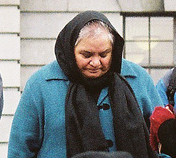- Tariana Turia
Infobox Officeholder
honorific-prefix =
name = Tariana Turia
honorific-suffix =
MP
order = Co-leader of theMaori Party
term_start =7 July 2004
term_end =
predecessor = "Position established"
successor =
constituency_MP2 = Te Tai Hauauru
term_start2 =2002
parliament2 = New Zealand
predecessor2 =Nanaia Mahuta
successor2 =
majority2 = 5,113cite web |url=http://2005.electionresults.govt.nz/electorate-66.html |title=Elections NZ 2005: Official Count Results – Te Tai Hauauru]
birth_date = birth date and age|1944|04|08|df=y
birth_place = flagicon|New Zealand
spouse =
occupation =
religion =Ratana cite web |url=http://www.nzherald.co.nz/section/1/story.cfm?c_id=1&objectid=10488712 |author=New Zealand Herald |date=25 January 2008 |title=Key offers pledge on Treaty process |author=Claire Trevett |accessdate=2008-01-25]
party = LabourMaori Party Tariana Turia (born
8 April 1944 ) is aNew Zealand politician. She gained considerable prominence during the foreshore and seabed controversy, and eventually broke with her party as a result. She resigned from parliament, and successfully contested a by-election in her former electorate as a candidate of the newly-formedMāori Party .Early work
Turia was born in 1944 to an American father and
Māori mother. Her Māori roots are Whanganui, Ngati Apa, Nga Rauru, and Tuwharetoaiwi . Before entering politics, she had considerable involvement with a number of Māori organisations, working withTe Puni Kokiri (the Ministry of Māori Development) and a number of Māori health providers. She also had associations with the Te Kura Kaupapa andkohanga reo movements.Member of Parliament
Turia entered the
New Zealand Parliament in the 1996 election as alist MP for the Labour Party, ranking 20th on the party list. In the 1999 election, she remained a list MP, but ranked sixteenth. In the 2002 election, however, she contested the Te Tai Hauauru Māori electorate, and opted not to place herself on the party list at all. Te Tai Hauauru (roughly, the Māori voters of the west of theNorth Island ) returned her as their member of parliament.Although never a member of Cabinet, Turia has held a number of non-Cabinet ministerial roles. From Labour's electoral victory in
1999 , she served as Associate Minister of Māori Affairs, Associate Minister of Social Services and Employment, Associate Minister of Health, and Associate Minister of Housing. In2002 , she also became Associate Minister of Corrections. After the formation of the Labour-Progressive coalition in2002 , she dropped the Corrections role and gained full ministerial rank as Minister for the Community and Voluntary Sector.Foreshore and seabed legislation
When debate about ownership of New Zealand's foreshore and seabed broke out in 2003, and the Labour Party proposed vesting ownership in the state, Turia voiced dissatisfaction. Along with many of her supporters in Te Tai Hauauru, she claimed that Labour's proposal amounted to an outright confiscation of Māori land. When it became publicly known that Turia might vote against Labour's bill in parliament, tensions between Turia and the Labour Party's leadership increased. The hierarchy strongly implied that if Turia did not support Labour policy, she could not retain her ministerial roles.
By-election
On
April 30 2004 , after a considerable period of confusion about Turia's intentions, she announced that she would resign from parliament on17 May . This precipitated aby-election being called in Te Tai Hauauru, which Turia contested as a member of the newMāori Party that formed around her. On the same day that Turia announced her resignation, Prime MinisterHelen Clark sacked her from her ministerial posts.Her supporters see Turia as having bravely defied her party in order to stand up for her principles. Her critics, however, portray her as dangerous and racist. The Labour Party has criticised Turia for putting the foreshore and seabed issue before the party's wider policies for Māori development, and says that she has unreasonably focused on a single issue. Helen Clark said that Turia had shown "an astonishing lack of perspective". Turia described the Te Tai Hauauru by-election of
10 July 2004 as a chance to test her mandate, and to ensure that she had the support of her voters, but doubts remained about the significance of the by-election, since none of the major parties put forward candidates. Labour called the event "a waste of time and money".Turia received 92.74% of the vote in the by-election, and resumed her seat in Parliament on
27 July 2004 .2005 general election
On
September 17 2005 , the Māori Party contested the general election with electoral candidates in all seven of the Māori seats. Turia was re-elected in Te Tai Hauauru and that night three more Māori Party candidates won parliamentary seats,Pita Sharples (co-leader) in Tamaki Makaurau,Hone Harawira in Te Tai Tokerau andTe Ururoa Flavell in Waiariki. The winning of the four seats resulted in celebration for their supporters who anticipated seeing an independent, Māori voice in parliament. However, the Māori Party share of the party vote across the country was 2.1 percent, placing them sixth out of the eight parties in parliament by party vote. This was attributed to voters in the Māori electorates mainly giving their party vote to the incumbent Labour government.References
Wikimedia Foundation. 2010.
